INTRO:
Broken Age was a milestone of sorts for Double Fine as a studio. After the debacle that was Brütal Legend’s corporate sponsorships, getting financial support for its game development was not a smooth breeze. This game’s crowdfunding may have been a stirring success, but what came after showed that fulfilling promises is not so easy. Whether this game can be considered a success or not is debatable; if anything, it gave some harsh lessons that reality does not gel with high expectations.
On that note, Broken Age is, perhaps ironically, a story about coming of age. It works puzzles and obstacles into two characters’ journeys at learning that aspirations do not always turn out as they would expect.
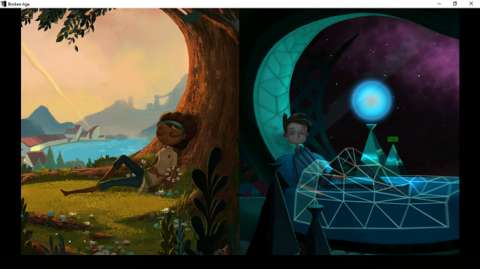
PREMISE:
The cover art for the game alone points out the settings for the game. There are two: one is a setting where wondrous things occur alongside hideous terrors, whereas the other is one with incredibly (and absurdly) advanced technology and overly-expressive artificial intelligences. For each setting, there is a protagonist of obvious youthfulness, but who has significant dissatisfaction with how things are.
Vella lives in a town in a world that has capitulated to massive hungry horrors. She has been selected as a sacrificial candidate. Understandably, she (and some other people) has misgivings about this, but said hungry horrors are horrific for very good reasons (like being invulnerable to many things). What is more irksome is that most other people have somehow learned to see the regular sacrifices in a positive light.
Shay is the only human that he himself knows about. He is the raison d'être for the AI’s, computers and robots of the space ship that he lives in. Despite having lived on the ship for as long as he can remember, he has begun to tire of the lack of fresh stimuli from his daily life and the protectiveness of his inorganic guardians.
In Shay’s case, his story starts with a slow burn as the (new) player figures out how to break out of his daily routine. Eventually, after meeting a shady character that has a particular interest in Shay’s coming of age, he began to do things that would jeopardize his own life and the integrity of the ship, just so that he has something significant to do.
In Vella’s case, the proverbial turd hits the fan rather quickly. Her drive to survive lets her escape from the huge horror that is about to swallow her, but she is left somewhere else with no immediate means of returning to her town, much less fight the horror.
MOAI ENGINE:
The game runs on the Moai Engine. The engine was developed with the intention of bringing C++ and OpenGL code, glued together with Lua, to mobile devices. This engine would allow mobile devices to run 2D graphics that are far more sophisticated beyond the Flash-like graphics that permeated mobile games in the early 2010s. The same engine also allows the game to run on other machines too.
NOTABLE LACK OF “EXAMINE” CONTROL INPUT:
For a game that is produced by people that had their roots in the long-defunct LucasArts, it can be an unpleasant surprise that not all of the usual control inputs for an adventure game are available for all of the possible control schema. In particular, the “Examine” control input is missing in the mouse-based control scheme. There does not seem to be any way to enable it.
Therefore, the only control input that the player has for having the player character interact with anything is whatever default that has been set. For example, clicking on an NPC would have the player character talk to the NPC. With the mouse schema, there is no way to have the player character examine the person.

TO-AND-FRO:
For the entirety of the playthrough, the two player characters are not with each other at all. This is mainly due to story-based circumstances that separate them.
The player can swap between either player character at any time. This game is hardly the first adventure game to do so. However, this is the case for the entirety of the playthrough, and not just for specific scenarios like in the other games.
LITTLE OVERLAPPING:
The storytelling in the first Act strongly implies that either player character’s journey happens at the same time as the other’s. However, due to their mostly completely separate circumstances, the player can play either’s story at the player’s own pace. Virtually none of the obstacles that one player character would encounter would be encountered by the other, and vice versa.
One would wonder why there is a feature to swap between the player characters when their circumstances do not depend on each other’s efforts. Indeed, the player may even wonder whether they are within the same universe or not. However, the end of the first act will show that their stories are indeed intertwined with each other.
In the second Act of the story, there are two occasions when the player must obtain a clue from the other player character’s environments. These two can be a tad unbelievable, considering that the current player character has no believable way of knowing how to come across that clue. He/She even mentions that they have a “hunch” that what they would do will work.
MOVING ABOUT:
The computer version of the game has most of the usual point-and-click control schema, with the exception of the aforementioned absence of examining things instead of doing anything else.
The player character’s exact location does matter in the case of locales such as Meriloft, which is made of cotton-like clouds. There are also more than a few places where the proximity of the player character to something also matters to the progression of the playthrough.
Expectedly, most of these scenarios involve hazards. However, convenient circumstances give them enough plot armour so that the player does not have to reload game-saves. (The game has a very low age rating too.)
INVENTORY:
Just like the protagonist of most other adventure game, either protagonist can carry about a plethora of things, including large objects that should appear somewhere on the player character’s person. As is typical of the traditions of point-and-click adventure games, this absurdity is never addressed.
However, there is generally no more than one row of items in the user interface of the game on a wide-screen monitor, assuming that the player is an item hoarder.
Thanks to sci-fi elements in the storytelling, a number of items that reside in either protagonist’s inventory happen to be sentient and will make remarks on certain things. Players who want to listen to as many of the voice-overs as possible will want to keep them around, if only for the humour.

DIALOGUE & MONOLOGUE - OVERVIEW:
All dialogue is given voice-overs. Other than the subtitles and dialogue options, there is almost nothing for the player to read, because almost every written article that can be seen in the game appear to be chicken scratches. Incidentally, where there are such illegible things, at least one character – usually the player character –will read them aloud. This is perhaps a blessing for people who are reading-impaired.
Therefore, for the purpose of this review article, the quality of the dialogues and monologues will be described together with the quality of the voice-overs.
That said, none of the characters appear to have matching lip-synching. Utterances from any character are accompanied by comical mouth animations that are mainly only there to give the semblance of speech.
All of these likely have been intended for the purpose of easy localization of the game, though perhaps at the cost of some finesse in the presentation of the game.
REMARKS:
One of the hallmarks of adventure games is that the protagonist always has a lot to say about something, somewhere or sometime, even if there is no one around to hear them. The two in this game are no different.
Amusingly, there are moments in which their remarks about something can be heard by someone else that is close by. That person would then add their own remarks. Incidentally, such occurrences are foreshadowed moments before by a peculiar re-positioning of the camera.
As for the remarks that the protagonists would make, most of them depend on dry wit to carry any intended humour across. Besides, both characters live in rather cloistered environments, especially Shay, and know little about the places and things outside of their homes. Even Vella, who knows that she lives in a world that has other places and people, is not entirely familiar with the customs and livelihoods of other people who live elsewhere.
The cases of where other characters overheard their remarks are generally more amusing than the ones where they talk to themselves. This is because the other characters reveal facets about their personalities and other character details.
CONVERSATIONS:
There are not a lot of adventure games that can be done well if there is not some back and forth between characters, be they the player characters with somebody else or NPCs with each other. In the first act of the game, most of these conversations highlight the circumstances of the world that they live in and how the player characters find them to be frustrating.
However, not everyone else accepts the status quo, which in turn foreshadow some things that would happen in Act 2.
Anyway, the only practical reason that the player would want the protagonist to talk to other people is to gain clues about what to do next or get reminders about what to do. The player should not expect everyone to be helpful though, either because they are preoccupied or they are just not bright. Still, there are certain phrases that they say that happen to be clues, though not all of them are direct.
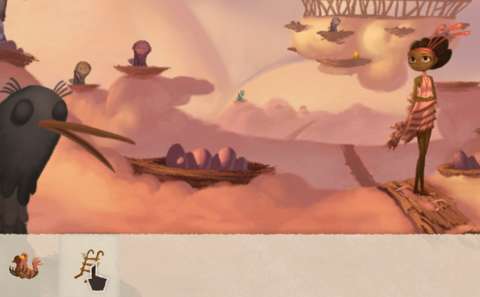
For example, in the penultimate scenes, Vella’s sister would make a childish quip about dancing when not knowing what to do next. This is a clue that the solution to the current puzzle might be about performance arts.
There are also some puzzle solutions that can only be started by completely picking all available dialogue options. This happens to be the case in at least two instances in the latter half of the game.
The only non-practical reason that the player would want the protagonist to talk to other people is to observe their response to some topical matter and to be entertained by it – hopefully. Sometimes, this may involve the solution to some puzzles. For example, there is a talking tree that gets queasy about trees being turned into woodwork, thus releasing his resinous sap.
For all the entertaining conversations that the protagonists would have with different people, it is notable that there is no conversation between the protagonists throughout the entire game. This omission is intentional and is quite amusing.
CHARACTER DESIGNS:
Many latter-day adventure games rely a lot on their characters to deliver their appeal. Thus, their success or failure depends on how much thought and effort that their writers and voice-talents invested in them. This being a Double Fine production with costs that go into the millions, the game must deliver or else, especially considering that their audience include jaded adults that had decades of experience with the adventure game genre.
Fortunately, good direction of the people who contributed to the character designs and their delivery minimized the consequence of their flaws, while eking out as much as possible from their performance.
Firstly, many situations in the story are quite calm. These situations let the voice-talents deliver their lines as much as they want for the audio designers to edit and implement later. Consequently, most characters are convincingly portrayed by their voice-actors and –actresses.
Secondly, and in relation to the previous passage, there are only several tense moments in the game. These mainly involve the protagonists with few, if any, other characters around. Voice-talents that are capable of giving convincing performances for characters that are under duress are few and far in between. Thus, it is fortunate that most of them get drafted for the aforementioned tense scenes.
Thirdly, the voice-talents that voiced the protagonists got the bulk of the directors’ attention at casting. Elijah Wood may have been great in the Lord of the Ring’s movies, but some mediocre performances in video games have marred his portfolio. Thus, he was cast in the role of Shay, a bored, often listless and socially awkward boy – as befitting Wood’s merely-decent performance at reading lines. Masasa Moyo, who is the voice for Vella, has a far longer portfolio at voicing animated characters, and thus mostly convincingly delivered Vella’s lines.
Yet, there are scenes where the characters’ activities within the same scene may seem a tad unbelievable. For one, they can seem oblivious to anyone that is within the same scene but is in distress. In the case of the automatons on Shay’s ship, this may seem justified because the automatons are generally none too bright at doing anything beyond their main functions.
However, humans that have lived lives loving other people but appear oblivious to someone in distress can seem too much. Such scenes can be seen in the latter half of the game, such as the seaside settlement of Shellmound in the aftermath of the end of Act 1.
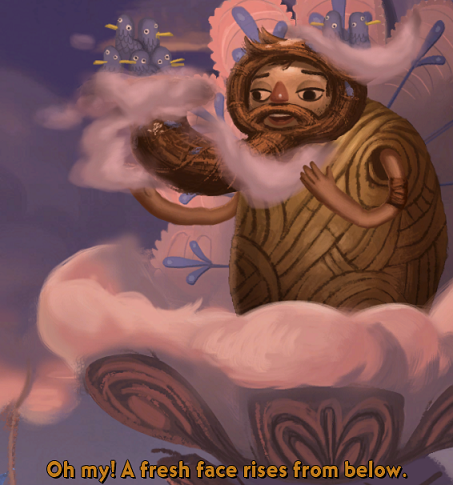
USING THINGS ON OTHER THINGS:
Most solutions in the first Act require the player character to use something on something, someone or somewhere else. Indeed, there are few solutions that can be solved in other ways.
This might seem a tad narrow in design scope, but it does give the game’s developers excuses to implement sprites and animations, especially for the player characters. For example, watching Vella get up to mischief and tossing away things that are no longer useful is amusing.
More importantly, trying to use something on something else may result in responses or reactions that might be entertaining. Indeed, the player can spend a lot of time doing this just to see how much that the game’s designers have invested into all of the possible item permutations.
ASSOCIATION AND DEDUCTION PUZZLES:
In Act 2 of the game, there are puzzles that require the player to make observations and deductions. Chief of these are the re-wirings of the circuits in the robots that maintain Shay’s ship. For example, the player will want to observe the scorch marks on the housing of a damaged robot, so as to figure out the direction of the wires that would be re-laid.
Incidentally, these also require the player to swap player characters in order to find clues, or otherwise exercise the player’s relative omniscience with regards to the protagonists’ situations. (This has been described earlier.)
These require substantially more intellect than the usual use-something-on-something-else puzzles. Understandably, there were some complaints about how these puzzles were unpleasant surprises to people who are more used to the typical item-combining or –using puzzles. Of course, there is always the snide counter-argument that these people should get out of their comfort zones.
LOGICAL ELIMINATION PUZZLE:
There is only one puzzle in the game where actual written language is shown and has to be read. This happens to be a logical elimination puzzle. The clues to this puzzle happen to include pictures that do have written text, such as Arabic numerals. Some of these pictures have hand-written text too. (These would have been a hassle for the various localizations of the game.) A certain character also makes statements that require the player to have some ability at comprehending the key elements about what they are saying.
This will be easy for players who can think systematically. However, the designers of this puzzle would try to hurry this along by having the player character draw out a table diagram with text labels for columns and rows. This would be convenient for players who happen to prefer such visual aid in solving logical puzzles; the players can just take a screenshot of the diagram and use it elsewhere. On the other hand, this might irk players who somehow perceive this as an insult to their intelligence.
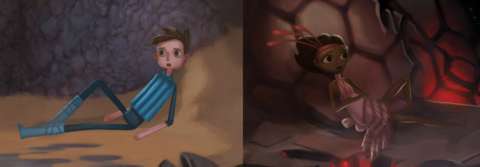
CONVENIENT BIZARRENESS:
Having played the entirety of the game, observant veterans of adventure games might notice that there are items that have little context for being around, or have enough believability for that matter. Most of them are implemented through the conveniently bizarre elements of the story.
The most prominent of these are the bizarre themes in the engineering of Shay’s “space-ship”. For example, there is the prominence of yarn on Shay’s ship, which conveniently justified the presence of knitting utensils. Likewise, there are the economic themes for the settlements that are shown in the game. For example, Sugar Bunting is a town of bakers, and their buildings happen to look a lot like giant cookie jars.
The presence of such whimsy is used as the excuse for the presence of objects that the player needs to solve puzzles. For example, the “cloudshoes” that are needed for life on the clouds of Meriloft would be useful items in more than one occasion in Vella’s parts of the game.
The bizarreness would have been more acceptable if there had been more explanation about the world that the game takes place in. Yet, there is not a lot of it. For one, people like Vella are aware of the existence of electronics and space-ships, even though the settlements that the player would see do not have a single piece of latter-day tech. For another example, there is no believable explanation for why the clouds of Meriloft are so capable of supporting the presence of wooden structures, or that there is a large peach tree growing and fruiting on one of them.
VISUAL DESIGNS:
If it is not obvious already, adventure games do not have much gameplay complexity. Puzzles can only be so clever before their designs become all too familiar to long-time veterans. Thus, present-day adventure games depend greatly on either their storytelling or their aesthetics to carry their appeal.
The whimsical designs of the characters and the world are obvious from the get-go. Many human characters are only vaguely humanoid, with something about them that is comically off.
For example, Vella has a body that is the closest facsimile to a late-teens girl, but her face is a horizontal oblong. One of the robot characters even mention that the normal size of her head still seems a bit too big.
The most common examples are the long thin arms for many characters. Some of them are properly segmented, like Shay’s. Some are animated like the arms of characters in Adventure Time, e.g. noodle-like and stringy.
Perhaps the most notable visual element about the characters in this game is the variety in the shapes of their heads and facial features. They vary wildly, even for characters that are supposed to be related to each other.
The events in the game are implied to happen in a period of time that is short enough such that everyone wears the same clothes throughout the game. This would have been convenient for the game’s artists and animators. It also makes for some amusing circumstances.
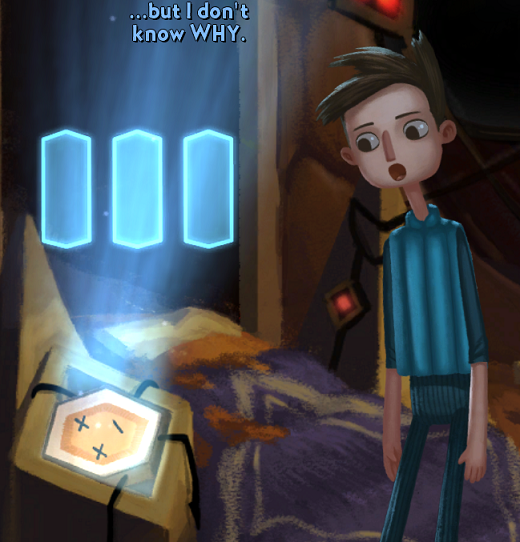
For example, Vella is in a half-torn dress throughout the entire game. This circumstance is all the more amusing considering that she would be stowing away a lot of things in clothes that is already showing quite a lot of skin. She is also bare-footed most of the time. There are scenes in which other characters have noticed either circumstance. On the other hand, no one wonders aloud where Vella is keeping her stuff.
As for the world, much of it is made of static 2D artwork. Some of the tense scenes do have sprites with layers for the purpose of simulating destruction. The 2D artwork has been given slightly different lighting and shadowing, so that they contrast well against the characters so that they can be recognized but not too much that their placement looks unpolished.
Other than 2D layers for characters and environmental artwork, there are plenty of particle effects to look at. Other than the “snow” that appears in some rooms on Shay’s ship, the particle effects that the player would see are mostly smoke and embers, so the player should expect particle effects to appear in scenes of destruction.
OTHER SOUND DESIGNS:
The voice-overs have been described already. There are other sounds to hear from the game, of course.
For one, there is the music, which is composed by long-time composer and former LucasArts staffer Peter McConnell. There is a considerable variety of tracks, each of which has been made for specific occasions. For example, the playfulness of the whimsical tracks is noticeable, such as the raspberries that can be heard in some of the early-game tracks for Shay’s segments, when the humour of Shay’s daily routine is shown.
There are some tracks that are endemic to specific places. For example, there is the track that plays when the player character is at Meriloft. As befitting a pretty place of great beauty that provides safe roosting for large birds, there is a serene track that plays there.
The sound effects take a back seat to the other audio assets. Other than the loud noises in the tense scenes, the audio designers prefer to keep them short or even keep them out whenever convenient. There are some scenes where craftspeople ply their craft off-screen just before handing the player character something.
For example, the audio designers could replicate the sounds of Carol the shoemaker making shoes. However, they did not bother with the noises about the woodworking or metal casting that Curtis the former lumberjack would do.
SUMMARY:
Broken Age may not have been an entirely smashing success, despite its rather rousing Kickstarter crowdfunding achievement. Having to be published in two instalments, both of which have Early Access phases, did not exactly paint a nice picture about having aspirations achieve reality.
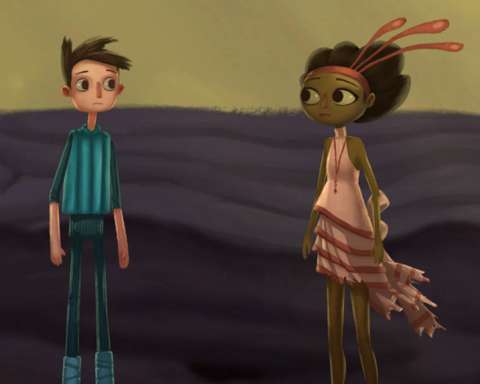
Still, Broken Age made it to completion. There may be gaps in the storytelling, such as there being not much exposition on the lore behind the world that the game takes place in. However, the rest of the appeal of storytelling was delivered anyway, such as reliable casting and direction of voice-overs.
The use of 2D artwork might have been a step back, considering that Double Fine had made many games with 3D graphics. Fortunately, the game does have the typical Double Fine whimsy, specifically its use of different visual styles for different games where possible.
Overall, Broken Age is far from a waste of time. It has enough of a balance of things that are familiar to long-time followers of adventure games and things that would amuse even jaded players.

